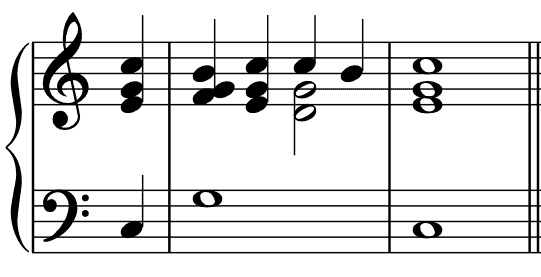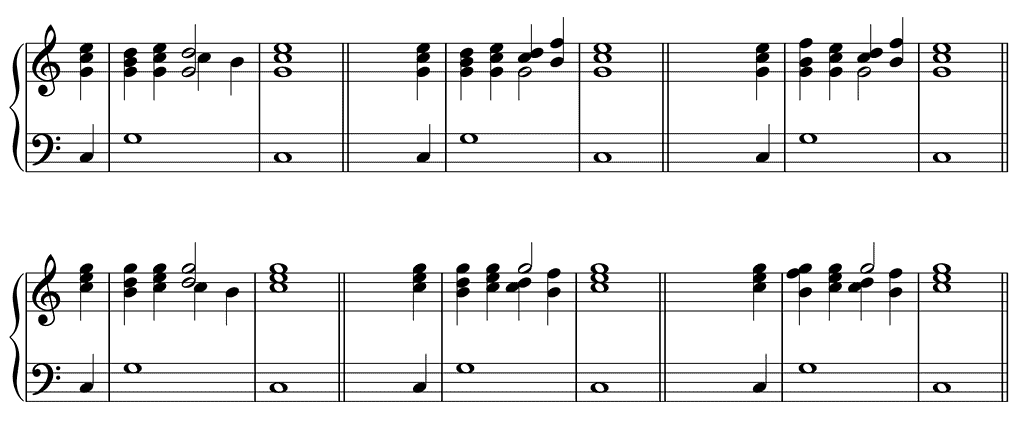One of the first things a partimento student in the Neapolitan tradition had to study were three types of cadences: the simple cadence (cadenza semplice), the compound cadence (cadenza composta) and the double cadence (cadenza doppia). Those cadences are based in the sources on a ①–⑤–① bass progression.
The type of cadence largely depends on the length of ⑤. When ⑤ lasts 1 beat, a simple cadence with 1 sonority above ⑤ was usually played. When ⑤ lasts 2 beats, a compound cadence with 2 sonorities above ⑤ was played. When ⑤ lasts 4 beats, a double cadence with 4 sonorities above ⑤ was played.
In this essay, these three types of basic cadences will be illustrated in three positions, stipulating which sonorities can be played on ⑤ for each cadence. To encourage you to play the musical examples at the keyboard and memorise them that way, no audio files are included in this essay.
Cadenza Semplice/Simple Cadence
When ⑤ lasts 1 beat, a simple cadence or cadenza semplice was usually played. This type of cadence is characterized by the presence of only one sonority above ⑤. This sonority can be not only a triad, but also a seventh chord.
First Position
The following example shows the simple cadence in first position in a four-part texture. First position means starting on ➊ in the top voice.

Note that the version with the seventh on ⑤ usually does not include the fifth of the chord (➋); the seventh replaces the fifth on ⑤ and the bass note is doubled. That way, the three subsequent chords are ‘glued together’ thanks to the common note ➎.
The following example shows the simple cadence in first position in a three-part texture.

Note how the upper voices move in parallel sixths when only triads are used. When ⑤ is set with a seventh, however, the upper voices move in contrary motion.
Second and Third Positions
Below you can see the simple cadence
- in second and third positions in a four-part texture
- in second position in a three-part texture.
Second position means starting on ➌ in the top voice, third position on ➎ in the top voice.


Practising the Simple Cadence
Make sure to practise the simple cadence
- in all three positions in a four-part texture
- in first and second positions in a three-part texture
- with the triad and the seventh chord on ⑤
- in all common keys.
Cadenza Composta/Compound Cadence
When ⑤ lasts 2 beats, a compound cadence or cadenza composta was usually played. This type of cadence is characterized by the presence of two sonorities above ⑤ or, more precisely, by a 4–3 suspension.
First Position
The following example shows the compound cadence in first position in a four-part texture.

Note that, in reference to ⑤,
- the first sonority can be a 5/4 or a 6/4 chord
- the seventh can replace the fifth during the resolution of the 4–3 suspension.
Note also that the partimento maestros did not wait to introduce dissonances until a later stage of the training, as is common in modern theory. The concept of dissonance and consonance was addressed from the start, resulting in genuinely musical solutions.
The following example shows the compound cadence in first position in a three-part texture.

Second and Third Positions
Below you can see the compound cadence
- in second and third positions in a four-part texture
- in second position in a three-part texture.


Practising the Compound Cadence
Make sure to practise the compound cadence
- in all three positions in a four-part texture
- in first and second positions in a three-part texture
- with a 5/4 and a 6/4 chord as the first sonority on ⑤
- by replacing the fifth by the seventh during the resolution of the 4–3 suspension
- in all common keys.
Cadenza Doppia/Double Cadence
When ⑤ lasts 4 beats, a double cadence or cadenza doppia was usually played. This type of cadence is characterized by the presence of four successive sonorities above ⑤: 5/3 (or 7/3), 6/4, 5/4 and 5/3 (or 7/3). In fact, one can consider the realization of ⑤ of the cadenza doppia as a succession of the right hand of the cadenza semplice and the cadenza composta (with its 4–3 suspension), respectively.
First Position
The following example shows the double cadence in first position in a four-part texture.

There is also a version of the double cadence starting with a seventh chord on ⑤ and ending with a triad:

The following example shows the compound cadence in first position in a three-part texture.

Second and Third Positions
Below you can see the double cadence
- in second and third positions in a four-part texture
- in second position in a three-part texture.


Practising the Double Cadence
Make sure to practise the double cadence
- in all three positions in a four-part texture
- in first and second positions in a three-part texture
- with a 5/3 chord as the first sonority on ⑤
- with a 7/3 chord as the first sonority on ⑤
- with a 5/3 chord as the last sonority on ⑤
- with a 7/3 chord as the last sonority on ⑤
- in all common keys.
Which Position?
The choice of position depends not only on melodic decisions but also on the impact one wants a cadence to have. Cadences in first position are more suitable for ending phrases, sections or pieces, while cadences in second and third positions are less concluding.
Further Reading (Selection)
Primary Sources
Fenaroli, Fedele. REGOLE MUSICALI PER I PRINCIPIANTI DI CEMBALO, A Comparative Edition (V1.0), compiled and edited by Ewald Demeyere (Ottignies, 2021).
Secondary Sources
Gjerdingen, Robert O. Music in the Galant Style (New York: Oxford University Press, 2007).
Gjerdingen, Robert O. Child Composers in the Old Conservatories — How Orphans Became Elite Musicians (New York: Oxford University Press, 2020).
IJzerman, Job. Harmony, Counterpoint, Partimento: A New Method Inspired by Old Masters (New York: Oxford University Press, 2018).
Sanguinetti, Giorgio. The Art of Partimento — History, Theory, and Practice (New York: Oxford University Press, 2012).
